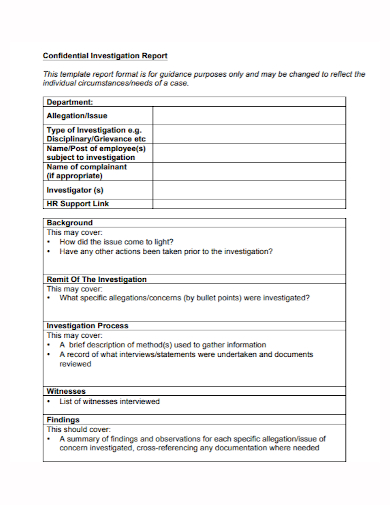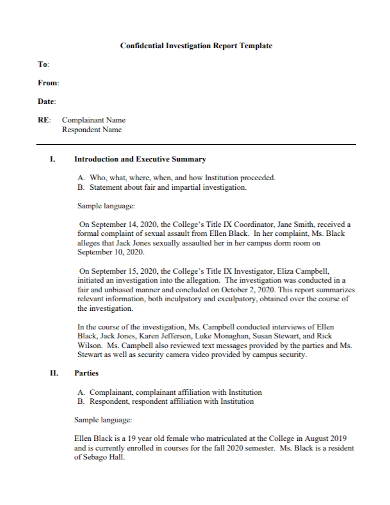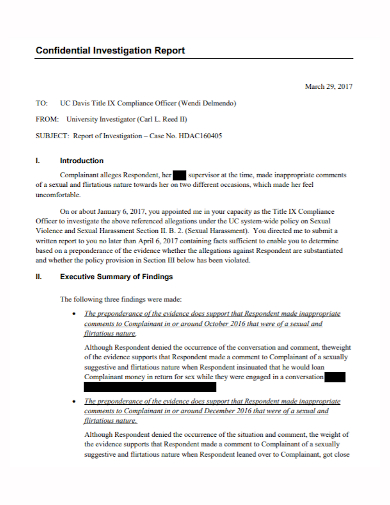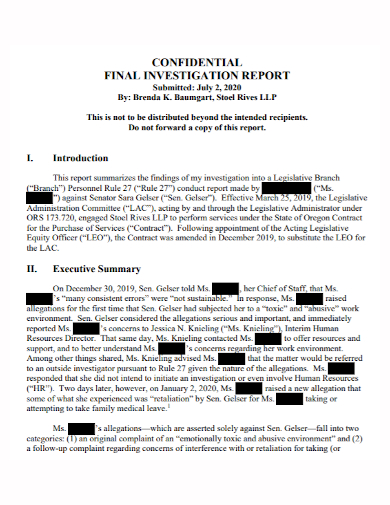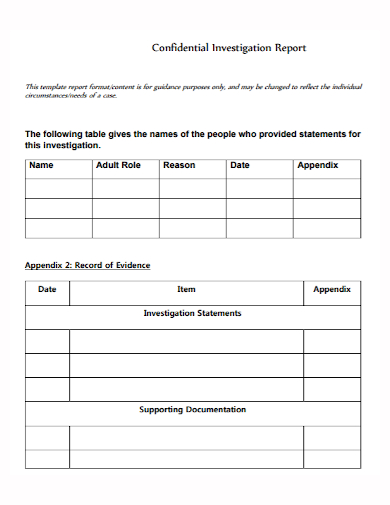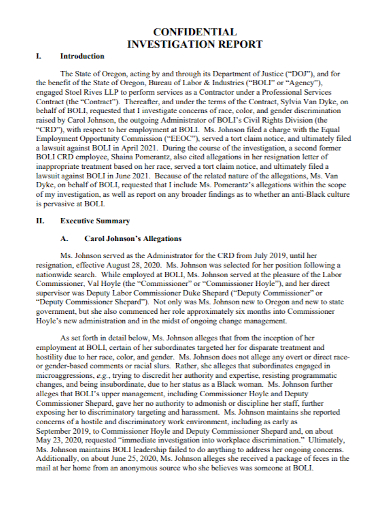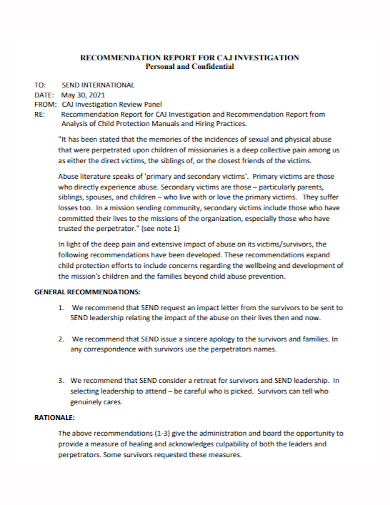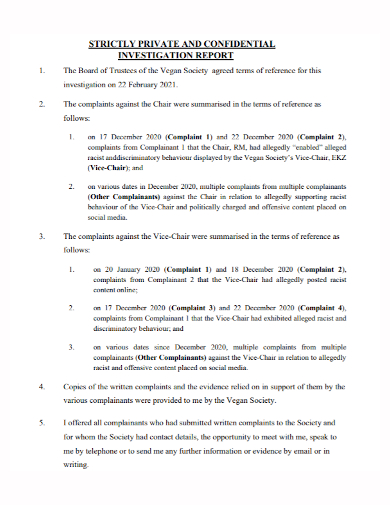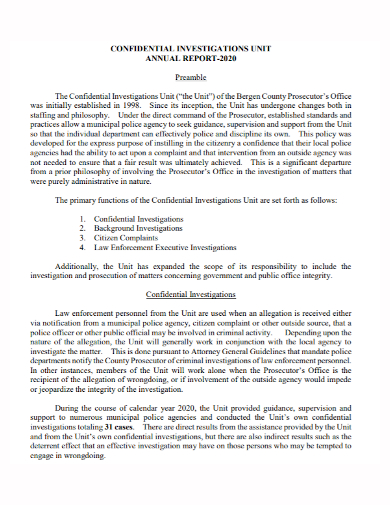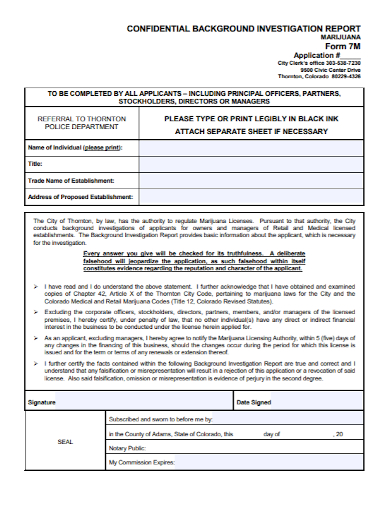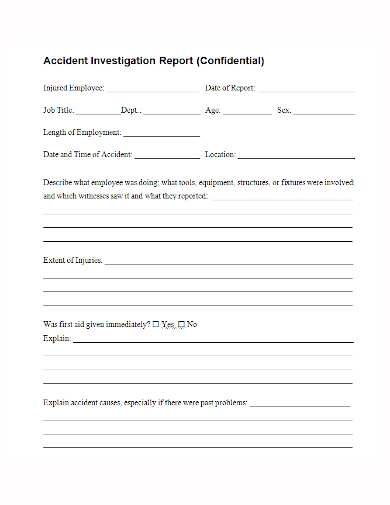An investigation report is defined as a type of document that provides specific details about the findings of an investigation whenever there is a complaint filed or a specific incident occurs. Investigators, then, are obliged to make records about the issues of a subject matter, make an analysis of the evidence, and make a conclusion in relation to the findings. This type of report does not consider any sort of opinion from the investigator or to anyone involved. It has to be based on evidence. In this article, you will be able to know more about the context of what a confidential investigation report is and how to create one.
10+ Confidential Investigation Report Samples
1. Confidential Investigation Report
When choosing for a template, you should know first that confidential investigation reports has the purpose of helping each of the investigators ensure a complete, up to date, and accurate investigation of a particular allegation or complaint. Having a complete collection of evidences and investigation report with the use of an organized template will help you to easily provide information about the subject of an investigation, provide specifications of the type of case, document evidences and interviews, identify the disposition contained in an investigation, and complete an investigation report with affixed signatures.
2. Confidential Complaint Investigation Report
3. Officer Confidential Investigation Report
4. Confidential Final Investigation Report
5. Sample Confidential Investigation Report
6. Executive Confidential Investigation Report
7. Personal Confidential Investigation Report
8. Strictly Confidential Investigation Report
9. Confidential Investigation Annual Report
10. Confidential Background Investigation Report
11. Confidential Accident Investigation Report
Content of a Confidential Investigation Report
The first thing you should see in the document are the following information arranged in a table:
- allegation or issue
- name/designation of the person subject to investigation (if appropriate)
- name of the complainant
- investigator(s)
- HR support/link
Background – this is where you are going to identify what actions have already been taken even before the investigation and what type of communication took place. Make sure to provide a short description about the subject of the investigation, their current role, and the details about their employment.
Executive Summary – this can be applied only for complex investigations. It is made specifically to provide a short summary of the findings or conclusion.
Remit of Investigation – this refers to the concerns that were determined as part of the need of an investigation. This must be presented using bullet points. It is made specifically to state what policy the investigation has been carried out.
Investigation Process – this section is where you will be explaining how the investigation has progressed. You should include the reasons why you made such decisions, a short description of the methods that were used to collect information, statements taken, character reference, timetable of events, and the evidences that were already reviewed.
Findings – your findings should be presented separately for each of the concerns and allegations. Identify the sequence of the events, cross-reference any documentation, and highlight any factors including management action, guide for procedures, etc. Take note of any actions that will demonstrate policies that did not meet the expectations.
Conclusion – you should be able to provide facts based on opinions whether there is an existing specific evidence to support any of the allegations and the strength of each of those evidences. You should also support your conclusion with the strongest evidence you have without having to repeat the main body of the investigation report. Draw out some key facts including the code of conduct, financial regulations, etc.
Appendices – this refers to the chronology of events, statements from the witnesses, interview notes, medical advice, and other related matter.
FAQs
What is the importance of having a confidential investigation report?
Confidential investigation reports are essential in providing decision makers with some facts that are extremely needed in order to determine a course of action. They are designed to ensure that each of the case would be completed and accurately investigated.
What are some tips on writing an investigation report?
You should start with what you know, make sense of what you have, and formulate a conclusion.
It is not quite easy to write a confidential investigation report. Aside from following with the standard format and structure of the document, you should also have a dedication to keep the information acquired as confidential as possible. If you want to see more samples and format, check out some confidential investigation report samples and templates provided in the article for your reference.
Related Posts
Sample Chemistry Lab Reports
School Accomplishment Report Samples & Templates
Field Report Samples & Templates
Sample Science Project Reports
Business Report Samples & Templates
Survey Reports Samples & Templates
Sample Feasibility Reports
Psychological Assessment Report Samples [ Clinical, Child, Intake ]
Report Format Samples & Templates
Acknowledgement for Internship Report Samples [ Hotel, Hospital, Teaching ]
Field Trip Report Samples [ Agriculture, Educational, Environmental ]
Student Counseling Report Samples
Narrative Accomplishment Report Samples [ Science, Teacher, Reading ]
Sample Acknowledgment Report Templates
Internship Narrative Report Samples

